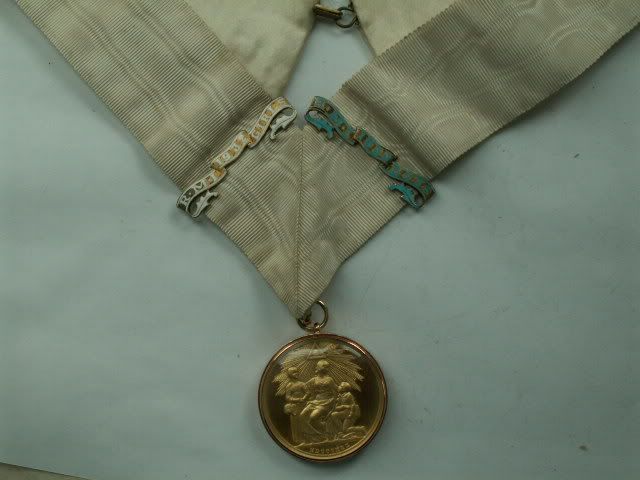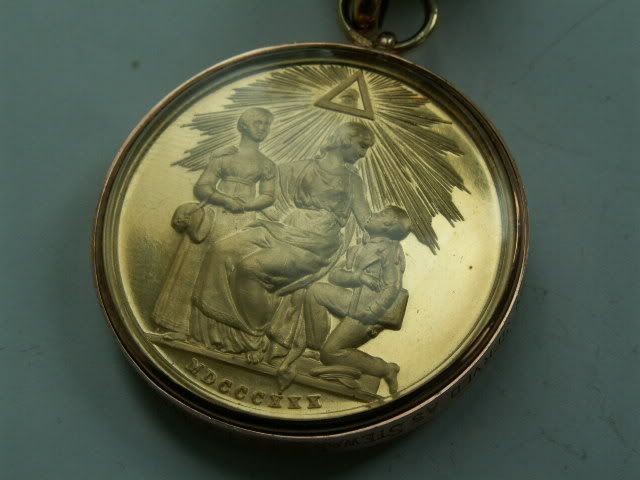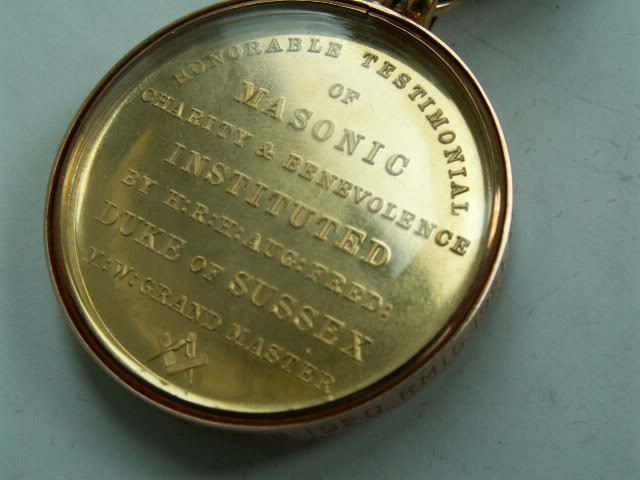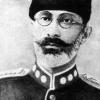-
Posts
4,254 -
Joined
-
Last visited
-
Days Won
11
Content Type
Profiles
Forums
Blogs
Gallery
Events
Store
Posts posted by paul wood
-
-
Wow, thanks for info.
Does anyone know if this is real gold under glas?
It is preaty heavy ca. 35 gr
0 -
Basically its gold value I am afraid, masonic material, unless it is very early, i.e. 18th century or if the recipient is famous in his own right (or if they are with a group of unnamed campaign medals thus giving provenance) is not widely collected. I would guess around ?150
All the best,
Paul
Many thanks for your reply.Any idea about value?
0 -
I have seen this Masonic Testimonial Medal on several occasions. It was a masonic Meritorious Service award generally given to those who had served their lodge with distinction over many years. The medal within the glazed case is gold (certainly up to WWII and from its institution in the 19th century). It is certainly one of the more attractive masonic pieces. I suspect that that the medal is 9 carat , lthough in some of the 19th century pieced I have encountered the gold may be of a higher purity.
Hope this is of help,
Paul
I need info about this medal.Medal is covered with glas. It is marked 9 375 and some other signs for 9 K gold.
On the edge is written probably name of the owner Bro : Lloyd Wilson Served as Steward to the R.M.I.B. 1920 R.M.I.G. 1924 R.M.B.I. 1931
I do not collect masonic items but I like this one. It is very nice made. I am curios what material could be medal it self?
It looks like gold or at least gold plated.
Any info would be appriciated.


 0
0 -
If you wish to see a veritable array of Serbian pieces see ANS part 1 Morton and Eden 24-25/5/06. Which is available on mortonandeden.com and follow archived sales link. Included were a breast star of Milosh and a neck badge, various insignia of Takovo amongst others.
Paul
These are wonderful.I hope you can make larger scans so the detail on these beautiful awards is clearer. (An Epson scanner works best for allowing you to easily control sizing and resolution).
I have NEVER seen a Milosh
 before, and have not seen any grade of Takovo in 30 years.
before, and have not seen any grade of Takovo in 30 years.  0
0 -
I am absolutely certain that is a genuine medal and absolutely of the period, the style also suggests that it was made probably by a local jeweller or silversmith rather than by a well known engraver of the period or at one of the major mints extant at the time.
Paul
0 -
Looking into my preliminary notes about the medal, I found that the University of Groningen has a website, where the 1672 siege is briefly described, and a picture of the obverse of the medal is shown. If you take a look at this photography you will clearly see the same "blob" as on my own.
I tend to think now that it is a good way of insuring it is a genuine piece. What do you think?
Very best regards
Veteran
0 -
Looking into my preliminary notes about the medal, I found that the University of Groningen has a website, where the 1672 siege is briefly described, and a picture of the obverse of the medal is shown. If you take a look at this photography you will clearly see the same "blob" as on my own.
I tend to think now that it is a good way of insuring it is a genuine piece. What do you think?
Very best regards
Veteran
0 -
Looking into my preliminary notes about the medal, I found that the University of Groningen has a website, where the 1672 siege is briefly described, and a picture of the obverse of the medal is shown. If you take a look at this photography you will clearly see the same "blob" as on my own.
I tend to think now that it is a good way of insuring it is a genuine piece. What do you think?
Very best regards
Veteran
0 -
Looking into my preliminary notes about the medal, I found that the University of Groningen has a website, where the 1672 siege is briefly described, and a picture of the obverse of the medal is shown. If you take a look at this photography you will clearly see the same "blob" as on my own.
I tend to think now that it is a good way of insuring it is a genuine piece. What do you think?
Very best regards
Veteran
0 -
I tend to agree with you, what appears to be upper weakness on the intital images now appears as a die fault anot uncommon occurence in the latter part of the 17th century.
All the best,
Paul
And while we are at it, here is the obverse of the medal, which shows the same untouched edge.Best regards again
Veteran
0 -
A very nice example of the medal. I notice that at the top of the medal, both sides there is a weakness which suggests that it may have sometimes been mounted for wearing. Is this the case? Or is it just a weakness in the strike. If the former then it could have been worn by the recipient with pride. A good and very interesting purchase.
Paul
A few weeks ago, I requested information about the medal awarded in 1672 to the students at the University of Groningen who defended the citY. Several members of this forum came up with excellent suggestions.I was able to secure one at auction. It appears to be quite scarce (after all, it was given to only 120 men some 335 years ago !) and the classic book "Orders and Decorations of the Netherlands" by Meijer, Mulder & Wagenaar did not have one to show with their description of the medal. In view of this, I thought the members of the club might enjoy seeing it.
My grateful thanks to the fellow members who generously shared their knowledge and best regards to all.
Veteran
0 -
Andy many thanks for that. I have always thought that the short lived order of Milosh the Great is one of the most beautiful European orders.
Paul
KF made them and has stamp on medal itself0 -
Many thanks Andy.
First Milosh case I have ever seen. Does it have a maker's name inside the lid, I believe Fischmeister made the majority of them.
All the best,
Paul
Mistake on last.I only have 1 boxed.Heres 4 Karagorges to make up0 -
For your Info.
It sold for ?1,150 and the gentleman who bought it was absolutely delighted with it.
Paul
Thanks Paul,I saw the medal (beautiful photography) and the Great East Asia War Medal illustrated was not the same as the one illustrated in Peterson's monograph. Jeff Floyd solved the problem when he stated that he had sold the medal he purchased from Peterson's estate and it was the medal used for the photograph in his book. The Kanji on Peterson's Medal reads from left to right. The medal sold at Morton and Eden was not the same as the rare version described on page 51 of Peterson's book as the latter inscription reads from right to left. Thanks for your great input. I think we may now put this matter to rest.
Keep Collecting!
Dick LaTondre
0 -
ANS part 3 Morton and Eden 26/4/07 lot 239. Image available WWWMortonandeden.com. follow links for past sales.
All the best,
Paul
Is there anyone out there in 'collector land' that has, or has ever seen, an 'original' Great East Asia War Medal as described in Peterson's monograph published by OMSA.Thanks for taking your time for reading this and more thanks for any input you may have.
Richard LaTondre
0 -
Nice little group of Obrenovich material. Any chance of detailed images of the Milosh and the case and also the Takowa medal and case.
Many thanks
Paul
Hi andy, greetings from vienna. Nive pieces you have. Cased Milosch the Great, Wow - Respectmaybe we can have better pictures of your collection
regards
haynau
0 -
The one on the far right (red and blue sash) is the Liberian Order of the Star of Africa.
Paul
Thanks Megan,As you can see, they have quite the nice collection.
Matt.
0 -
There are some fantastic orders there. My favourite is the Order of St Michel awarde by Louis XIV to the Dutch merchant Huydecouper, mid 17th century with original bestowal document.
Paul
Great Pictures, I think I will have to visit this museum myself once....But then... when ?
Will have to mark this place as a "thing-to-do"!
0 -
Dear Christophe,
What an interesting photograph of the erstwhile Duke of Albany, must have been taken late 1930's or early 1940's
Paul
A close up of his medals. If you have more photos about Carl Eduard, please post them. ThanksRegards
Christophe
0 -
As it is marked 14K it would suggest that is of US production probably for a lodge of expatriate Scots (Many Scots emigrated to the U.S.A. in the 18th and 19th century). It may be worth contacting and American masonic website for more detailed information. Masonic jewellery is not heavily collected possibly worth trying E-bay once you have more information about the piece.
All the best,
Paul
Thanks Mike.......
No my field of collecting, ...Is there a collectors market for those?
...and ......$...?
0 -
Peter you are absolutely right I was getting the two confused. Thank you for putting me on the right track.
Paul
Hi Paul, welcome to the forum
 . I have to give a different wiew though, the Merit Decoration isn't that hard to find. What you probably refer to is the Knight 2nd class i.g. silver with white enamel. This was awarded to foreigners, hence it's rarity. Swedes were awarded the Knight 1st class, gold with white enamel.
. I have to give a different wiew though, the Merit Decoration isn't that hard to find. What you probably refer to is the Knight 2nd class i.g. silver with white enamel. This was awarded to foreigners, hence it's rarity. Swedes were awarded the Knight 1st class, gold with white enamel.KR
Peter
0 -
What an extremely nice example of the Merit Decoration of the Order of the Sword. Much harder to come by than the Knight's badge.
Paul
Kim, of course it should be the Polar Star and not Vasa, as incorrectly suggested by me
KR
Peter
0 -
-
I have seen 3 or 4 in my time but have never seen one that has obviously been worn but the tradition of medals (apart from orders) for wearing really did not occur until the latter part of the 18th century, one only has to look at the Louisburg and Germantown medals, or the 17th century naval rewards that they were issued as table medals, one does see from time to time medals which have been adapted for wear by having a loop adapted, especially on the first two mentioned and it is more than probable that some of these medas were similarly adapted. There is another medal of this era issued by the Dutch for the suppression of the Amsterdam Riots, 1696 and presented to the Civic Guard. It came in gold and silver, 58, 46 and 39 mm, the larger designed by Jan Luder, the smaller by Jan Boskam. The obverse depict Neptune in a chariot pulled by two sea horses on a stormy sea, MOTOS PRAESTAT COMPONERE FLVCTVS above, reverse a nest with two doves on a calm sea, sun setting on the horizon, within a central scroll HALCYONIBUS REDVCTIS SENATVS AMSTELOD. CIVIBVS. SVIS. HOC ANTIQVAEVIRTVTIS SPECTATAEQ. FIDEI PRAEMIVM. LARGITVR.
I have seen several of these medals and I know of a gold one which appeared in a Dutch auction many years ago. The silver examples are not uncommom especially in the smaller size and a reasonable example of such should be obtainable for no more than ?300.
Hope this is of interest,
Paul
Thanks, Paul. Is there any evidence -- historical, artistic, or numismatic -- that it was converted for wear?0




Interesting Masonic "medal" Sussex 1931
in Masonic Medals & Jewels
Posted · Edited by paul wood
Oops pressed wrong button. From those I have encountered where the glazing has got broken they are definitely gold, whether this continued after WWII I don't know as to carat, 9 carat generally although some of the earlier 19th century ones may be higher.
Paul (PS Delete the next post)